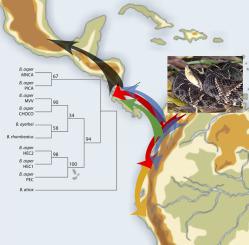Journal of Proteomics ( IF 3.3 ) Pub Date : 2020-08-20 , DOI: 10.1016/j.jprot.2020.103945 Diana Mora-Obando 1 , David Salazar-Valenzuela 2 , Davinia Pla 1 , Bruno Lomonte 3 , Jimmy Alexander Guerrero-Vargas 4 , Santiago Ayerbe 4 , H Lisle Gibbs 5 , Juan J Calvete 1

|
Bothrops asper is a venomous pitviper that is widely distributed and of clinical importance in Mesoamerica and northern South America, where it is responsible for 50–80% of all envenomations by Viperidae species. Previous work suggests that B. asper has a complex phylogeographic structure, with the existence of multiple evolutionarily distinct lineages, particularly in the inter-Andean valleys of north South America. To explore the impact of the evolutionary history of B. asper on venom composition, we have investigated geographic variation in the venom proteome of this species from the populations from the Pacific side of Ecuador and south-western Colombia. Among the 21 classes of venom components identified, proteins from mainly four major toxin families, snake venom metalloproteases (PI- and PII-SVMP), phospholipases A2 (K49- and D49-PLA2s), serine proteinases (SVSP), and C-type lectins-like (CTL) proteins are major contributors to the geographic variability in venom. Principal component analyses demonstrate significant differences in venom composition between B. asper lineages previously identified through combination of molecular, morphological and geographical data, and provide additional insights into the selection pressures modulating venom phenotypes on a geographic scale. In particular, altitudinal zonation within the Andean mountain range stands out as a key ecological factor promoting diversification in venom. In addition, the pattern of distribution of PLA2 molecules among B. asper venoms complements phylogenetic analysis in the reconstruction of the dispersal events that account for the current biogeographic distribution of the present-day species' phylogroups. Ontogenic variation was also evident among venoms from some Ecuadorian lineages, although this age-related variation was less extreme than reported in B. asper venoms from Costa Rica. The results of our study demonstrate a significant impact of phylogenetic history on venom composition in a pitviper and show how analyses of this variation can illuminate the timing of the cladogenesis and ecological events that shaped the current distribution of B. asper lineages.
Biological significance
Bothrops asper, called “the ultimate pitviper” due to its defensive behavior, large body size, and medical importance, represents a species complex that is widely distributed from southern México southwards across north-western South America to north-western Perú. This work reports the characterization of the venom proteomes of B. asper lineages from the Pacific sides of Ecuador and south-western Colombia. Multivariate analyses indicate that variability in venom composition among the B. asper lineages is driven by proteins from four major toxin families, presumably in response to selection pressures created by recent and historical ecological conditions created by geological and climatic events from the Pliocene-Pleistocene to the present along the Central and South American Continental Divide. The emerging biogeographic pattern of venom variation, interpreted in the context of the current phylogenetic hypotheses, support and complement previously proposed evolutionary Plio-Pleistocene dispersal events that shaped the present-day distribution range of B. asper lineages. In addition, our venomics data indicate the occurrence of genetic exchange between Colombian and Pacific Costa Rican populations, which may have occurred during the second wave of B. asper migration into Mesoamerica. Our work represents a foundation for a future broader sampling and more complete “-omics” analyses to deepen our understanding of the patterns and causes of venom variation in this medically important pitviper.
中文翻译:

南美西北部的两种植物的毒液变异。
Bothrops asper是一种有毒的虫,在中美洲和南美洲北部广泛分布,在临床上具有重要的意义,在这里,Vi蛇科占蛇蝎科所有毒液的50-80%。先前的研究表明,B。asper具有复杂的系统结构,特别是在南美洲北部安第斯山脉间谷地中,存在着多种进化上不同的世系。探索B. asper进化史的影响在毒液成分方面,我们从厄瓜多尔太平洋一侧和西南哥伦比亚的种群中调查了该物种毒液蛋白质组的地理变异。在确定的21类毒液成分中,主要来自四个主要毒素家族的蛋白质,蛇毒金属蛋白酶(PI-和PII-SVMP),磷脂酶A 2(K49-和D49-PLA 2 s),丝氨酸蛋白酶(SVSP)和C型凝集素样(CTL)蛋白是毒液地理变异的主要因素。主成分分析表明之间毒液组合物显著差异B.续断以前通过分子,形态学和地理数据的组合确定的血统,并提供了在地理尺度上调节毒液表型的选择压力的其他见解。尤其是,安第斯山脉的海拔分区是促进毒液多样化的关键生态因素。另外,在散布芽孢杆菌中PLA 2分子的分布模式补充了系统重建分析中的扩散事件,该事件解释了当今物种近缘种的当前生物地理分布。在一些厄瓜多尔血统的毒液中,致癌性变异也很明显,尽管这种与年龄相关的变异并不像B. asper中报道的那样极端。哥斯达黎加的毒液。我们的研究结果表明,系统发育史对牡蛎毒液成分具有显着影响,并表明对这种变异的分析如何能够阐明形成双歧双歧杆菌谱系当前分布的成枝时间和生态事件。
生物学意义
Bothrops asper因其防御行为,巨大的体形和医疗重要性而被称为“终极子”,代表着一种物种复合体,广泛分布于墨西哥南部,南美南部,西北秘鲁和秘鲁西北部。这项工作报告了厄瓜多尔太平洋地区和哥伦比亚西南部的B. asper血统的毒液蛋白质组的表征。多变量分析指示毒液组合物中的间可变性B.续断沿袭是由来自四个主要毒素家族的蛋白质驱动的,大概是响应由上新世至更新世到中美洲和南美大陆分界的地质和气候事件所造成的近期和历史生态条件所产生的选择压力。在当前的系统发育假设的背景下解释的毒液变异的新兴生物地理模式,支持并补充了先前提出的进化型Plio-更新世传播事件,这些事件塑造了B. asper谱系的当今分布范围。此外,我们的venomics数据表明哥伦比亚和哥斯达黎加太平洋人口之间发生了遗传交换,这可能是在第二次B. asper潮中发生的。迁移到中美洲。我们的工作为将来进行更广泛的采样和更完整的“-组学”分析奠定了基础,以加深我们对这种具有重要医学意义的子的毒液变化的模式和原因的理解。



























 京公网安备 11010802027423号
京公网安备 11010802027423号